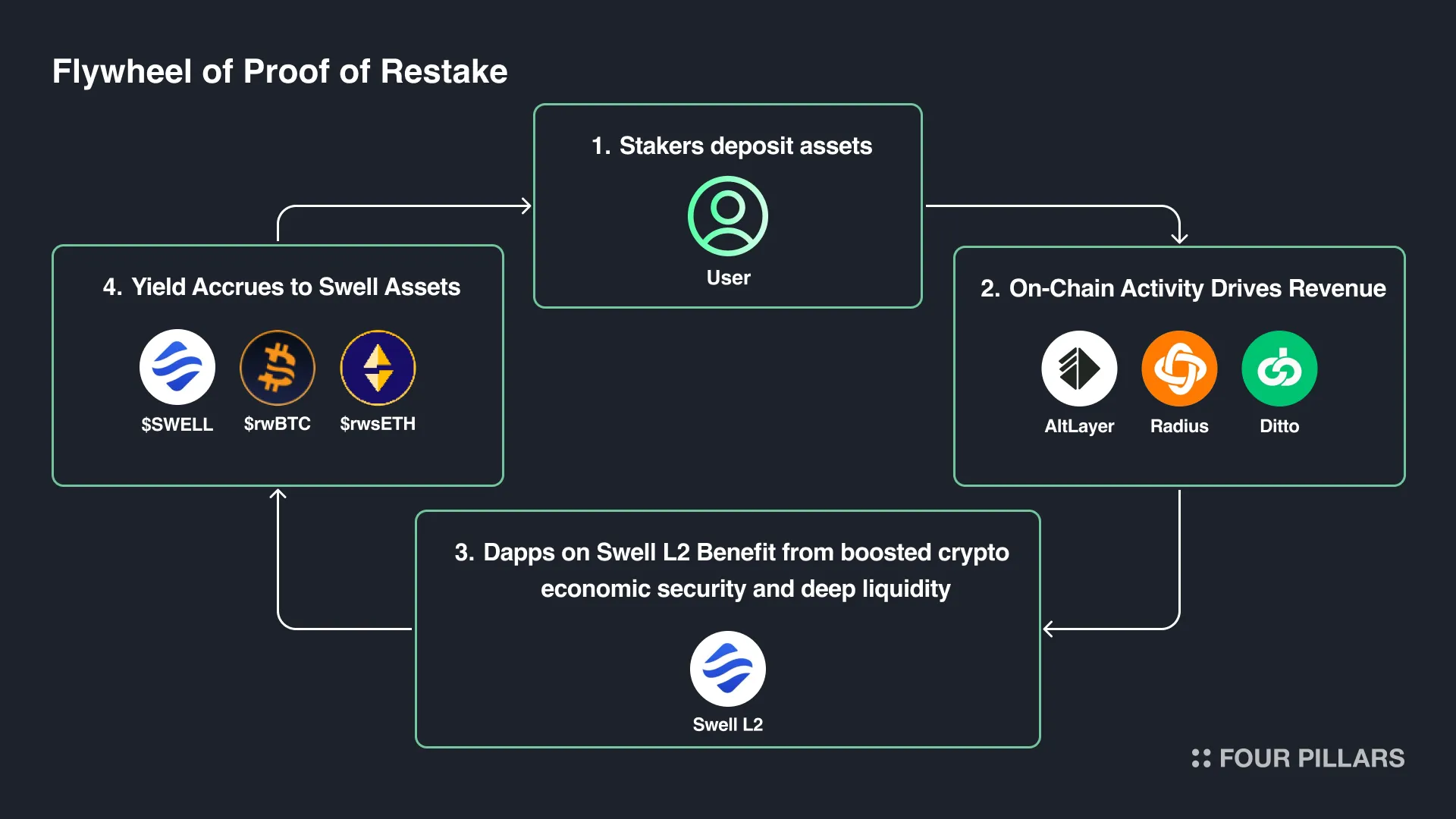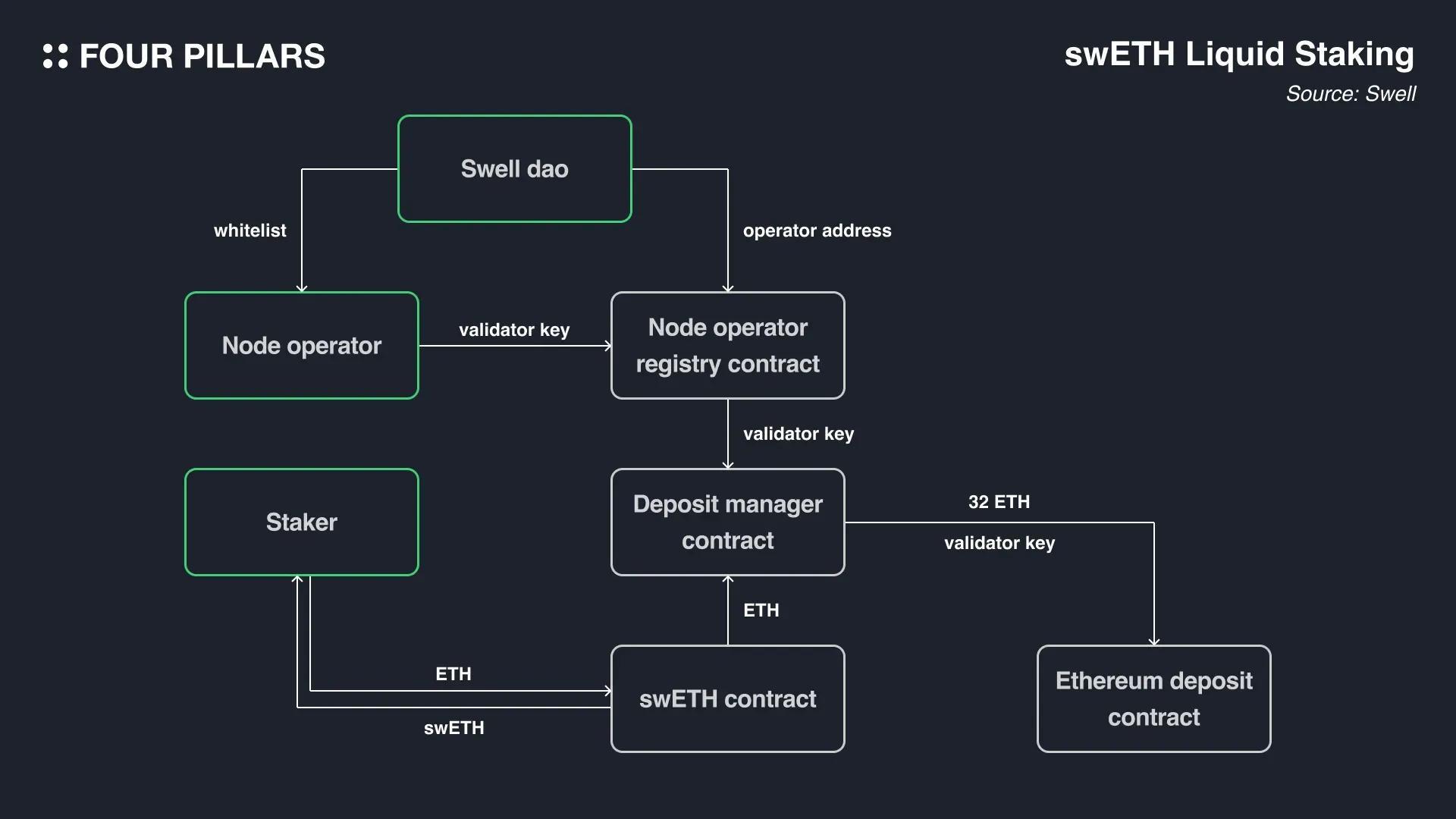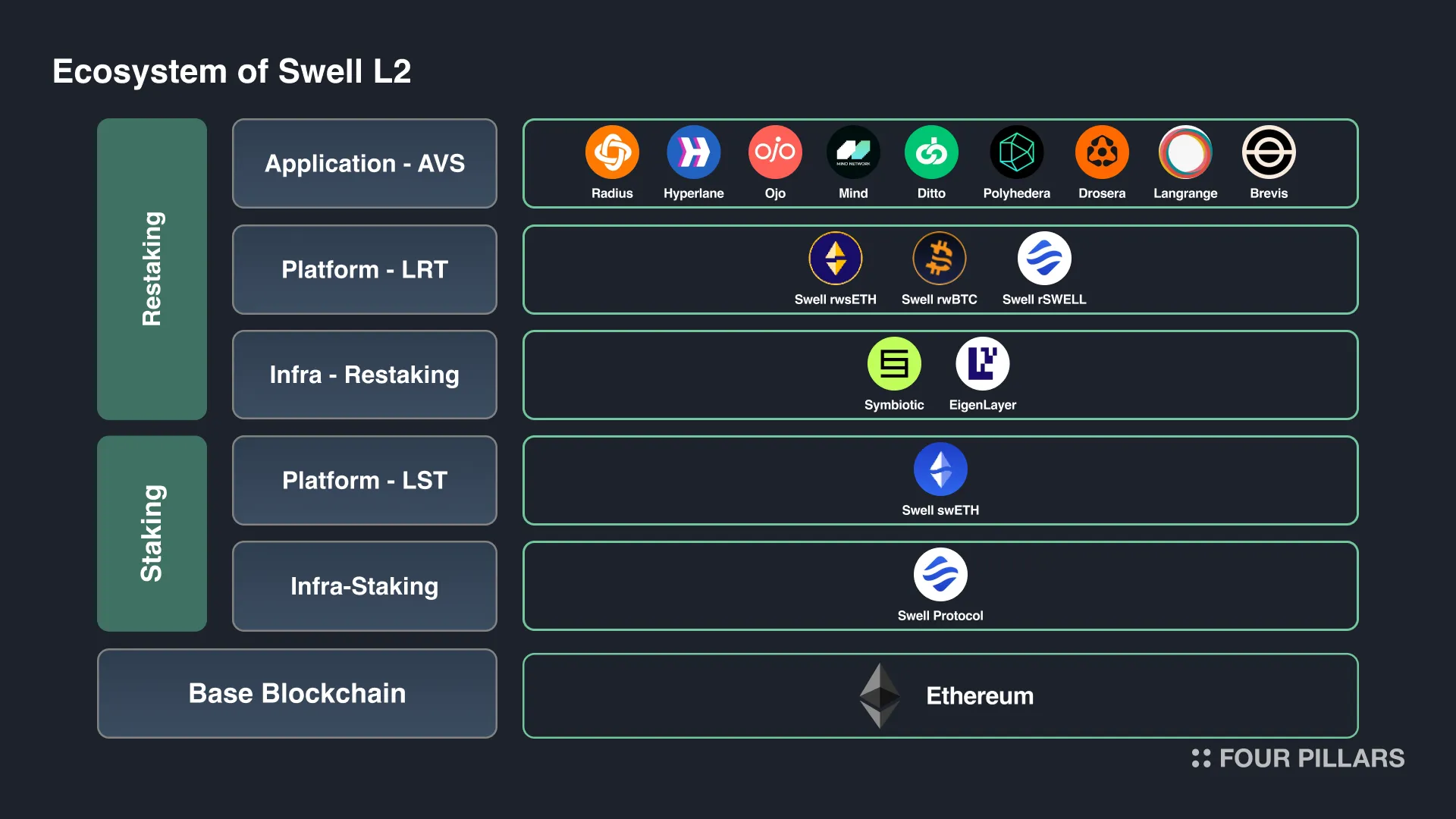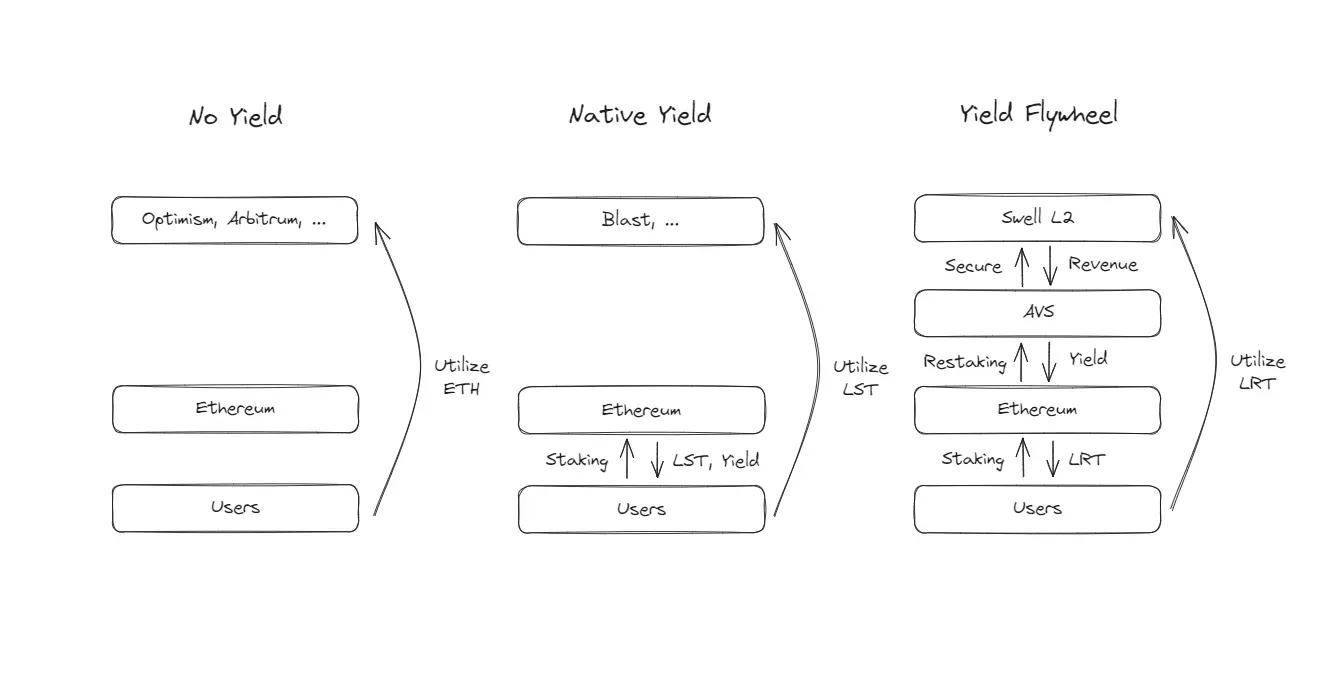Swell L2 announced its joining of Superchain, a collective of OP-Stack based rollups. It also introduced Proof of Restaking (PoR), a new incentive system that maximizes the utility of restaked assets through various AVS and the Swell L2 network.
Swell L2 aims to be a hub for all restaked assets, not just its own, and plans to integrate multiple restaking protocols and AVS.
The PoR mechanism in Swell L2 creates an incentive cycle economy. On-chain activities using rswETH generate revenue for AVSs, which then flows back into rswETH, potentially enhancing ecosystem liquidity, sustainability, and decentralization.
The trend in L2 ecosystem economics is moving towards providing more incentives to users and developers. Swell L2's PoR has been designed to maximize these incentives.
Swell, the Ethereum's liquid staking protocol, recently unveiled a concept called Proof of Restake (PoR) for its rollup, Swell L2. The PoR mechanism aims to maximize the utility of restaked assets through various AVS and the vertically integrated Swell L2 network, creating a incentive cycle in terms of security, ecosystem growth, and liquidity. This mechanism allows users to not only stake their ETH to earn rewards for securing the Ethereum network but also to "restake" their assets to secure AVS on EigenLayer, thereby earning additional rewards.
It should be noted that PoR does not act as a Sybil resistance mechanism in blockchain networks like the similarly named Proof of Work (PoW) or Proof of Stake (PoS). However, the name PoR is utilized because the underlying activity of a PoW network is mining with processors, and the underlying activity of a PoS network is staking of native assets, whereas the underlying activity of the Swell L2 network ecosystem is re-staking of assets.

Source: Proof of Restake: The Pioneering Mechanism Underpinning Swell L2
1.2.1 How LST/LRT is Minted

Swell supports liquid staking and liquid restaking of various assets. Here's how swETH, the liquid staking token for ETH, works:
A staker deposits ETH into a swETH contract, receiving an equal value of swETH in return.
The deposited ETH moves to the Deposit Manager contract. Once 32 ETH accumulates, a node operator is randomly chosen.
This operator then deposits 32 ETH into the Ethereum network using a validator key, initiating the validation process.
Swell's ETH liquid re-staking token, rswETH, follows a similar process. The key difference is that the 32 ETH is re-staked through EigenLayer instead of directly on the Ethereum network.
1.2.2 Other Swell Protocol Assets
Swell also offers swBTC and rSWELL:
swBTC: Unlike ETH, BTC is managed differently. The swBTC system centers around Aera Vault, a treasury management protocol created by Guantlet and Auditless. User-deposited WBTC is put to work through Symbiotic, Karak, and EigenLayer via Aera Vault.
rSWELL: SWELL, Swell's governance token, is expanding its utility. With EigenLayer's new permissionless token support, both EigenLayer and Symbiotic now allow re-staking of non-ETH tokens. This means SWELL will join the re-staking assets, evolving beyond mere governance to contribute to other protocols' economic security.
1.3.1 Mission of Swell L2
How will Swell L2 utilize different types of assets restaked through Swell? Swell L2 aims to be more than just an Ethereum L2—it strives to become a hub for liquid restaking tokens.
Swell L2 addresses risks common to existing Ethereum L2s, such as sequencer centralization. It achieves this by leveraging various infrastructure protocols that harness the security of EigenLayer and Symbiotic.
1.3.2 Overview of Swell L2
Swell L2 is built on the OP-Stack and uses Ethereum for DA. It also incorporates AltLayer's Restaked Rollup framework, which consists of three vertically integrated EigenLayer AVSes: SQUAD for decentralized sequencing, MACH for fast finality, and VITAL for decentralized verification.
Swell L2 further augments its ecosystem by utilizing several AVSes:
Radius: Provides decentralized sequencing and encrypted pre-confirmation, protecting rollups from malicious MEVs and single-point failures.
Ditto: Enables automated transactions and smart contract invocations under specific conditions.
Brevis and Lagrange: ZK Coprocessors that perform off-chain computation and smart contract data queries.
Ojo: A decentralized oracle network focused on ecosystem-native assets.

Source: AVS in Swell
By vertically integrating L2's own network for liquid restaking tokens with various AVS, Swell has the advantage of 1) solving the problems of the existing rollup ecosystem and 2) building a incentivized economic system.
Swell aims to solve the problems of existing rollups by vertically integrating with various AVSs. Of course, using an AVS means relying on the security scale of the re-staking platform for its functionality, which is naturally smaller than the security scale of the Ethereum network, but it is much safer than centralized methods such as sequencing, and it has the advantage of improving UX factors such as slow finality.

At its core, PoR aims to create an incentive cycle economy. Early Ethereum Layer 2 solutions like Optimism and Arbitrum improved network scalability, but users couldn't earn interest on their ETH holdings without converting them to liquid staking or re-staking tokens.
Blast seized this opportunity by introducing a novel concept: allowing native interest accumulation on ETH and USDB stablecoins on their L2 through ETH staking and Real-World Asset (RWA) protocols. This enabled users to earn interest on their holdings by default. However, the economic flow in this system was unidirectional and relied on external factors.
Swell L2 takes this concept further by vertically integrating various AVSs and using rswETH, a liquid re-staking token, as the native gas token. This structure fosters a virtuous economic system. When users engage in on-chain activities using rswETH on Swell L2, the AVSs handling various infrastructure roles generate revenue. These rewards then flow back into rswETH, creating a complete virtuous cycle unseen in previous L2 examples.
It's worth noting that AVSs don't transfer all the value they generate from Swell L2 to rswETH. Moreover, rswETH's EigenLayer operators aren't responsible for securing all AVSs, so it's not a perfectly closed economic loop. Nonetheless, building an ecosystem based on re-staking with this virtuous cycle in mind is a groundbreaking attempt. It will be fascinating to see if this approach can enhance the ecosystem's liquidity, sustainability, and decentralization as intended.
The Restaking Stack, a conceptual framework by Four Pillars, categorizes the main components of the restaking ecosystem. Swell demonstrates effective use of the entire stack and incentive system. Here's a concise explanation of each layer:
Based Blockchain Network: Foundation for staking/restaking, e.g., PoS blockchains like Ethereum.
Staking Infrastructure: Systems for staking native tokens to enhance network security. Swell protocol mints swETH from ETH.
Staking Platform: Offers native token staking services and liquid staking tokens, enabling users to use staked assets in DeFi while earning rewards. Swell's swETH is used across various DeFi platforms.
Restaking Infrastructure: Boosts economic security by allowing restaking of liquid staked assets. Examples include Symbiotic and EigenLayer.
Restaking Platform: Issues Liquid Restaking Tokens (LRTs) and enables user participation in restaking, with positions usable in other dapps.
Restaking Applications/Services: Decentralized apps using restaked assets to enhance security and functionality. These focus on specific functions like data storage, oracles, infrastructure verification, and cross-chain interoperability. Swell offers numerous services, with revenue flowing to users in Swell L2.

Source: Restaking Stack: Categorizing the Restaking Ecosystem | Four Pillars
Related Articles, News, Tweets etc. :